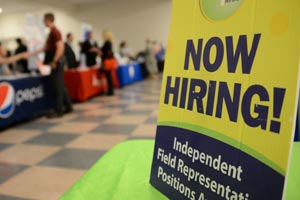Jobless Claims Dropped to 276,000 Last Week

Fewer workers filed applications for unemployment benefits last week, signaling the U.S. job market remains firm even after growth plunged at the start of the year.
Jobless claims decreased by 8,000 to 276,000 in the week ended May 30 from a revised 284,000 in the prior period, a Labor Department report showed June 4.
The median forecast of 52 economists surveyed by Bloomberg News called for 278,000. The total number of people receiving unemployment insurance payments was the smallest in more than 14 years.
Firings that have remained subdued mean employers could consider adding to staff as the economy emerges from a first-quarter slump. Job figures released June 5 from the Labor Department are set to show steady gains in hiring that should allow Federal Reserve officials to maintain confidence that labor-market progress is on track.
“There isn’t a whole lot of fat to trim” from the workforce, Gennadiy Goldberg, a U.S. strategist at TD Securities USA in New York, said of claims before the report. “Employers could certainly trim if things really did go sour, but it’s more of a story of let’s have enough workers to be able to meet extra demand when the pickup does come.”
Estimates for jobless claims in the Bloomberg survey ranged from 270,000 to 300,000. The Labor Department revised the prior week’s reading from an initially reported 282,000.
It was the 13th consecutive week that the number of applications held under 300,000, which economists say is consistent with an improving labor market.
Other figures showed the labor force was less efficient last quarter. Worker productivity declined at a 3.1% annualized rate from January through March, revised down from a prior estimate of a 1.9% drop, according to another Labor Department report.
After a 2.1% decrease in the fourth quarter, it marked the biggest back-to-back declines since 1993.
That’s making workers more expensive. Labor costs adjusted for productivity climbed at a 6.7% annualized rate in the first quarter, the report also showed. That followed a 5.6% increase from October through December, capping the biggest back-to-back gains since the six months ended in March 2007.
No states were estimated last week, and there was nothing unusual in the data, a Labor Department spokesman said as the claims report was released.
The four-week average of applications, a less-volatile measure than the weekly figure, increased to 274,750 from 272,000 in the prior week.
The number of people continuing to receive jobless benefits declined by 30,000 to 2.2 million in the week ended May 23, the fewest since November 2000. The unemployment rate among people eligible for benefits fell to 1.6% from 1.7%. These data are reported with a one-week lag.
While the persistently low levels of firings typically are associated with a healthy pace of hiring, bigger job gains have been slow to develop in the second quarter.
Employers added 223,000 jobs in April after 85,000 the prior month that was the lowest since June 2012. They’ve averaged 193,750 so far this year after a 259,670 tally in 2014 that was the best performance in 15 years.
Payrolls probably advanced by another 226,000 in May, according to the median in a Bloomberg survey of economists ahead of the June 5 report.
Signs of a rebound in demand are slowly emerging. Automobile purchases are among economic data that have been more upbeat since a string of disappointing figures pushed the Bloomberg Economic Surprise Index to its lowest level of the expansion at the start of May.
Sales of cars and light trucks reached 17.71 million in May at an annualized rate, the strongest level since 2005. Steady labor-market healing has kept automakers such as Ford Motor Co. optimistic about the outlook even as other data have been less consistent.
“In May, we continue to see mixed economic data,” Yong Yang, senior economist at Dearborn, Michigan-based Ford, said on a June 2 revenue call. “Nonetheless, labor market improvement remains robust. Overall, we believe that the underlying fundamentals supporting growth in 2015 remain in place.”
Federal Reserve policymakers are monitoring employment data as they consider when to raise the benchmark interest rate for the first time since 2006. While improvement has been sluggish in this expansion, Fed Chair Janet Yellen said she sees the labor market returning to health and helping to convince the officials to adjust policy accordingly.
“It is only now, six years after the recession ended, that the labor market is approaching its full strength,” Yellen said in a May 22 speech in Providence, Rhode Island. “If the economy continues to improve as I expect, I think it will be appropriate at some point this year to take the initial step to raise the federal funds rate target and begin the process of normalizing monetary policy.”

